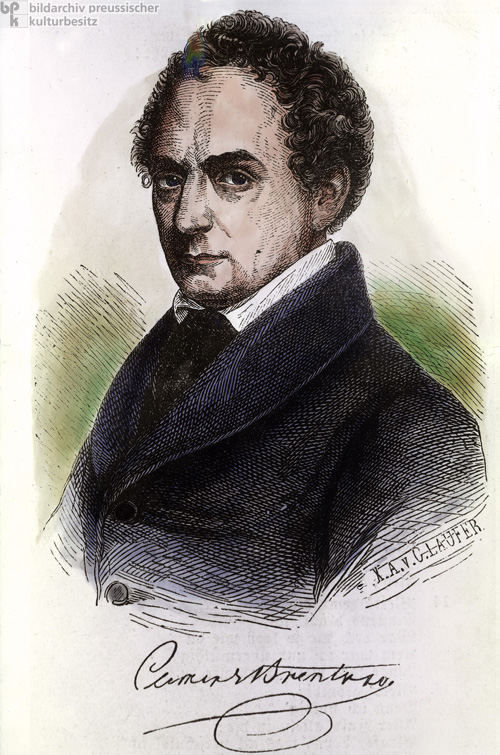|
Clemens Brentano (1st Half of the Nineteenth Century)
Along with Achim von Arnim (1781-1831), writer Clemens Brentano (1778-1842) was one of the leading representatives of the so-called Heidelberg Romantics, a group of Romantic writers who lived in the university town of Heidelberg and whose works were influenced by the earlier generation of writers known as the Jena Romantics. Brentano worked in various genres, writing novels, short prose pieces, dramas, and poems, as well as religious works. In 1801, while studying in Göttingen, he met Achim von Arnim, with whom he developed a close friendship. After the two had settled in Heidelberg, they collaborated on a successful collection of folkloric songs entitled Des Knaben Wunderhorn [The Youth’s Magic Horn] (1806/08). Beginning in 1808, the two men published the Zeitung für Einsiedler [Newspaper for Hermits]. In 1811, Arnim married Brentano’s sister Bettina, who went on to become a well-known Romantic writer herself. From 1809-11, Brentano lived in Berlin, where he was a founding member of the “Christian-German Roundtable Society” [Christlich-deutschen Tischgesellschaft], whose anti-Semitic manifesto he composed. Brentano’s lifestyle was characterized by instability: he moved from city to city and traveled a great deal. He was married twice; his first wife, the writer Sophie Mereau, died in 1806, and he was divorced from his second wife, Auguste Bußmann, in 1812. After returning to Berlin in 1815, he turned more strongly toward his Catholic faith and produced numerous religious works. In addition, he intermittently supported Political Catholicism, a movement initiated by the Catholic journalist Joseph Görres, whom Brentano had met during his time in Heidelberg. In 1833, Brentano moved to Munich, where Görres had already assumed a university professorship and had managed to assemble a group of politically like-minded supporters. During his lifetime, Brentano’s religious writings and fairy tales were the primary source of his literary success, but his reputation today rests primarily upon his poetic works, most of which were published posthumously. Colored woodcut by C. Laufer, first half of the nineteenth century.

|


